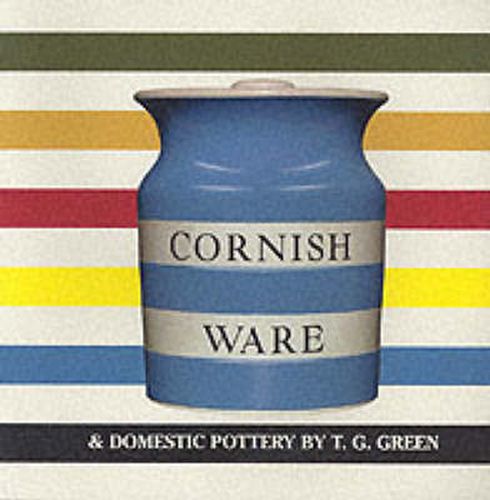Cornish Ware and Domestic Pottery by T.G. Green
Paul Atterbury

Cornish Ware and Domestic Pottery by T.G. Green
Paul Atterbury
One of the most enduring images of 20th century domestic life in Britain must be a kitchen filled with blue-banded Cornish Ware. Generations have grown up with this familiar striped pottery, as quintessentially English as the Morris Minor, Agatha Christie and village cricket. It is this familiarity, combined with a traditional taste for blue and white, that has made Cornish Ware so eminently collectable today, despite the hundreds of thousands of pieces produced since the 1920s, and despite the fact that it is still in production. Regular appearances in advertisements and on packaging, and in cookery and childrens’ books underline the ware’s universal appeal. Cornish Ware has nothing to do with Cornwall. It has been made since 1926 by T.G. Green & Company, a traditional domestic ware pottery in Church Gresley, Derbyshire. Founded in the late 18th century in the heart of a county well known for pottery, thanks to ample supplies of local coal and clay, the company was bought in 1864 by Thomas Goodwin Green, a successful builder and entrepreneur who had made a fortune in Australia. Under his dynamic leadership, the pottery became one of Britain’s leading manufacturers of kitchen, hospital and institution ware, domestic pottery, bowls and cookware, and tea and dinner wares, employing over 700 people in two factories, and remaining a family business until 1964. Cornish Ware made its first appearance in price lists, catalogues and advertisements from 1925 onwards. Its secret, and the reason for its immediate success and lasting popularity, was that every piece was turned on the lathe, to cut sharp-edged, clean bands through the blue slip to reveal the white clay beneath, a production technique still used today. It was known from the start as Cornish Kitchen Ware, and there is a story that it was named by Green’s south of England representative who saw in it the colours of Cornwall’s skies, clouds and white-topped waves. Earliest catalogues show that the range always included both kitchen and table wares, but most familiar have always been the black lettered storage jars, with over one hundred names recorded to date. The success of Cornish Ware inspired the development of new shapes and colourways, and related ranges such as the blue and white spotted Domino Ware and the cream and green-lined Streamline Ware, both introduced in the 1930s. An important export market was built up, helping to keep T.G. Green in business during the difficult years of the Second World War. Cornish Ware was soon re-established as a family favourite during the 1950s and in the late 1960s the range was restyled by Judith Onions, fresh from the Royal College of Art, and this is the basis of Cornish Ware today, still made in the same place and by the same techniques by Cloverleaf, who took over the pottery in 1987. Despite its popularity, Cornish Ware was only a small part of T.G. Green’s production, and the huge variety of tablewares and other domestic pottery made since the 1860s are increasingly of interest to collectors. When this book was first published in 1996 it concentrated on Cornish Ware. This new and much expanded edition documents and illustrates many other T.G. Green wares, along with much more Cornish Ware.
This item is not currently in-stock. It can be ordered online and is expected to ship in approx 4 weeks
Our stock data is updated periodically, and availability may change throughout the day for in-demand items. Please call the relevant shop for the most current stock information. Prices are subject to change without notice.
Sign in or become a Readings Member to add this title to a wishlist.


